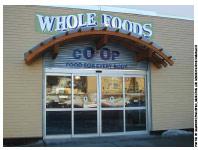Background: Lake Superior

Duluth, Minnesota: The night before we opened our new Whole Foods Cooperative location, we hosted a Premiere Party/35th Anniversary Party for our members. When the front doors opened, the sound of jaws dropping echoed across Lake Superior.
Over 1,500 people wandered through the store aisles, gawked at the new equipment, congregated with friends, sampled products from our greatly expanded selection, and cheered through the toasts and speeches. After an eight-year site search and another year of fund-raising and site development, there were still a few folks who were sorry to leave the old site (2,000 square feet of retail space and 5,000 square feet total), but even they showed up at the party.
Now we’ve got a couple months of operational experience in our 7,000 square feet of retail space (18,400 square feet overall) and are reasonably confident that we will exceed our $8 million first year sales goal. But the best part is we’ve just begun to realize the benefits of all the energy-minded decisions that went into remodeling a neighborhood bar and grill into a healthy environment for organic foods and for our customers, staff, and neighbors.
Our co-op’s mission statement includes a commitment “to the products and practices which make positive changes in the life of its community, employees and environment.” Way back at the beginning of our expansion process, we developed a concept paper to prioritize our hopes and dreams for how a new site could contribute some of those “positive changes.” But in the fall of 2004, when our Design Team was introduced to the How Do We Pay for This Team, we realized we had a lot more prioritizing to d0.
Our architects introduced us to two options for the greenest store we could afford: the Minnesota Sustainable Building Guidelines(B-3) and the LEED Program sponsored by the U.S. Green Building Council. We chose to seek LEED (Leadership in Energy and Environmental Design) certification for our project. LEED criteria recognize the same or higher values as the Minnesota program for site development and energy efficiency, as well as for efforts to promote alternative transportation, use of local and regional materials, and use of materials with recycled content. It also offers points for “innovation and design process”—an area where our public classroom, green housekeeping procedures, and use of chemical-free water on organic produce and in the deli earned us extra points.
We got a LEED point for reusing at least 75 percent of an existing structure. The building had originally been constructed in 1953 as a grocery. We also purchased a ready-to-condemn brick duplex behind our building and then donated it to a local nonprofit agency that teaches people how to do deconstruction and salvage, and operates a retail store for used building materials. The former duplex site is now used for staff and classroom parking and for outdoor events. Salvaging materials from this building was part of the construction waste management point, and the agency that salvaged materials from that building sold them for more than the appraised value of the building.
The main parking lot, which is shared with the credit union for more spaces and ease of access to both businesses, includes preferred spaces for carpooling. The building site is within a half block of four bus lines. And co-op staff have indoor bike parking and a staff shower.
Costs of LEED certification
With definite similarities to the organic certification process, documentation and auditing of applications for LEED certification was an administration-heavy process understood and supported by our general contractor, but not appreciated by subcontractors. But now that we’ve dragged them through the process and our store is on the growing list of area LEED projects, those subcontractors will likely be listing “LEED-experienced” on their résumés.
Not all the numbers are in yet, but I estimate the additional LEED-related costs for testing, documentation, application, and material choices to meet LEED standards added $15 per square foot to the project cost, although we would likely have made many of the same material choices regardless of LEED points. On the flip side, the LEED education we did among our members—and the fact that our primary outside lender, a co-op credit union, also incorporated LEED values in its building—helped us significantly in fund raising and in assuring our members that we were respecting as many environmental issues as we could.
The architects made a short film about our project, called “Extreme Grocery Store Makeover” and included it with our submission for LEED certification. We have one copy of this 25 minute DVD and could make more if other co-ops are interested.
At this point we are awaiting word on our level of LEED certification. Mounting that plaque will be cause for another celebration and the kickoff of a series of environmental awareness classes and store tours. With plaque or not, our building will be an accessible example for our community of a restoration project incorporating regional materials, recycled materials, sustainable materials, alternative energy, and energy efficient equipment.
***
Sharon Murphy has been the general manager at Whole Foods Co-op in Duluth, Minnesota since 1988 (smurphy@wholefoods.coop).







